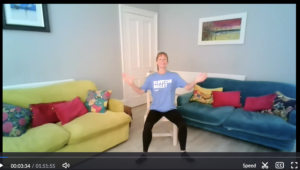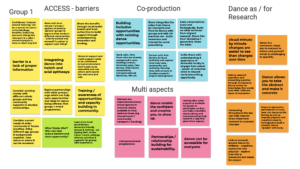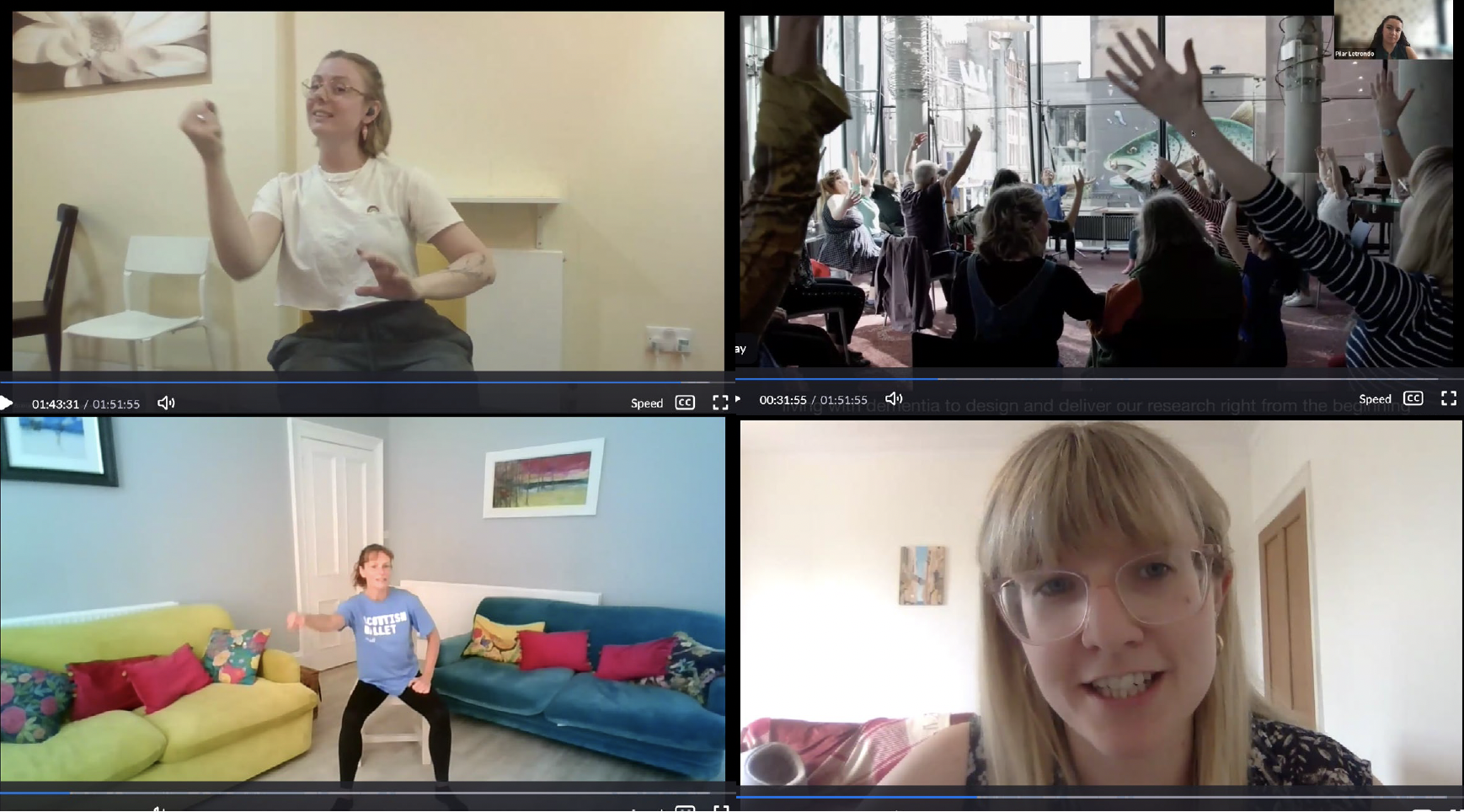On Tuesday 20th June 2023, we facilitated a 2-hour online workshop as part of our CREATE Dance for Dementia project which is aiming to Cocreate a REsearch Agenda To facilitate Equitable (CREATE) Dance for Dementia. 55 people attended the online workshop, including those living with dementia, carers and family members, researchers and students, health and social care professionals, dance organisational representatives, dancers, and those connected to policy organisations. The event was a mixture of practical dance activities, presentations and break-out room discussions. In this blog, we share what happened at the workshop and outline plans for the next steps in the CREATE project.
This project is funded by the Royal Society of Edinburgh and led by Dr Katey Warran at ECRED in partnership with Scottish Ballet and Dance Base (Scotland’s National Centre for Dance). Our core project team also includes Martin Robertson (lived experience researcher) and Pilar Letrondo (researcher at UCL). To learn more about the wider project, please visit the ECRED website. This was the second workshop as part of this project. To read more about the first workshop, click here.
Opening dance exercises from Scottish Ballet
Following a welcome note from Katey, dance artist Elaine Convery and musician Adam Stearns from Scottish Ballet facilitated two dance activities. The first activity could be engaged in either as a seated or standing exercise and involved getting our bodies moving to music. This ‘energiser’ activity was received very well by many, with participants noting it was ‘wonderful’ and ‘awesome’ in the chat box. The exercise also kick-started interesting conversations about how to ensure that dance is suitable for everyone as a couple of participants noted that they were feeling ‘overwhelmed’ by the activity.

The next dance activity involved imagining being on a beach and using our bodies to express our surroundings and feelings. We each entered into our own imaginary worlds to tell the story of what we could see. The exercise was used as an introduction to how dance can be used as an expressive tool that could support research. For example, it could be used as a data collection method to support participants with sharing how they are feeling in embodied ways.
Presentation and short film screening
Katey gave a presentation that outlined the background to the CREATE project. This included highlighting that:
-
Previous research has shown that dance is particularly beneficial for those living with dementia e.g., supporting communication, reducing isolation, loneliness, anxiety, stress and agitation and improving mood, quality of life and wellbeing
- A lot of previous research may be viewed as placing those living with dementia as participants to be ‘researched’, taking top-down approaches to knowledge and overlooking the role that those with dementia can play in cocreating research directions
- Understanding research processes are therefore important to work towards a more equitable future in dementia research
- The CREATE project aims to explore equitable, moral, and rights-based ways of working a diverse range of people to co-design research that is meaningful to them. Through this exploration, we aim to produce a publishable research agenda that sets out a collaborative vision for the future of Dance for Dementia research
A short film was screened containing footage from the first CREATE workshop, showing a range of conversations and dance activites that had taken place. Katey also summaried the key co-created research directions that stemmed from the workshop, presenting them as questions within three key themes:
Theme 1: Access
- What are the barriers of access to dance participation for those living with dementia? What needs to happen to reduce these barriers?
- Would integrating dance into health and social care pathways support those living with dementia? What role does social prescribing play in this? What are the challenges/opportunities?
- How can we enable personalised, culturally-sensitive and diverse forms of dance participation that acknowledges difference?
Theme 2: Coproduction
- Are changes needed in the research process (e.g., institutional, epistemological) to facilitate coproduction with those living with dementia? What needs to happen to make these changes?
- How can collaboration with health and social care professionals in view of their needs and attitudes be considered in coproduction?
- How can we ensure coproduction in this field is equitable and allows everyone to participate in the ways that they would like to?
- How can dance be used to facilitate co-research processes?
Theme 3: Measurement and Methods
- Is it possible to measure the intangible/subjective elements of dance for dementia experiences?
- Is dance currently positioned within a ‘clinical’ understanding in research on dance for dementia? What would a more holistic understanding look like?
- How can dance be used as a research method to explore experiences of dementia (for those with and without the condition)? (e.g., using dance to explore empathy)
Break-out room discussions
The focus of the rest of the workshop was on responding to the key themes, such as engaging in critical discussions on the topics and exploring what research directions may be missing. Participants were allocated into break-out rooms and discussed their responses, documenting key aspects of their discussions using Jamboard (a digital pin board):

Following the discussions, everyone came back together and discussed key points that stood out as important to the creation of a coproduced research agenda. This included:
- Ensuring that engagement with dance is measured ‘moment by moment’ in research, so that different experiences across engagement with dance can be ‘captured’
- Exploring the role of dance in bringing people together and social cohesion
- Recognising the incredibly important role of music to engaging in dance, for example examining the relationship between music and dance
- Viewing dance as “a way of communicating with your inner self”
- Tackling perceptions of “dance is not for me” that many people living with dementia may have
- Exploring the physical health barriers of access to engagement in dance
- Unpacking the challenges of the language of ‘dance’ and ‘ballet’ which may be off-putting for some. Could a move towards the language of ‘movement’ be more fruitful?
- Exploring not only who engages in dance, but who doesn’t engage and why
- Exploring the role of technology in Dance for Dementia, such as VR, and how VR experiences compare to in-person dance (e.g., running an RCT to explore this)
- Viewing dance as “another form of interaction” and exploring ways of researching interaction in the context of movement and dance
Exploring dance as a research method
Throughout the online session, Emma Smith from Dance Base interpreted the discussions using movement. We then ended our workshop by learning a movement sequence that summarised key points from the discussions. She created a piece that expressed:
- The importance of dance as a means to connect and bring people together
- The powerful role of music in dance participation
- How to capture feedback and evaluate dance activities in view of a range of perspectives and experiences
- Exploring “who isn’t coming” to engage in dance and why (i.e., the barriers of engagement)
You can see a short video clip of the sequence here:
Emma’s activity was also used to highlight the way in which dance can be used:
- As a data collection method in research. It could be used to explore feelings and experiences of living with dementia through using the body.
- As a way to communicate. It could be used by participants to communicate throughout any stage of a research process.
- As a dissemination tool. It could be used to share research findings. For example, Emma used movement to summarise and share the findings of this workshop!
Thank you to everyone who attended our workshop! The next stages in this project will be to bring together everything from across our two workshops (e.g., discussions, visual outputs, videos) and collate findings into a co-created research agenda that will be published. As the agenda develops, we will share it with workshop participants for feedback. To keep up to date with the development of the agenda, keep an eye on our website. If you would like to be involved in contributing to the agenda, please contact Katey.


